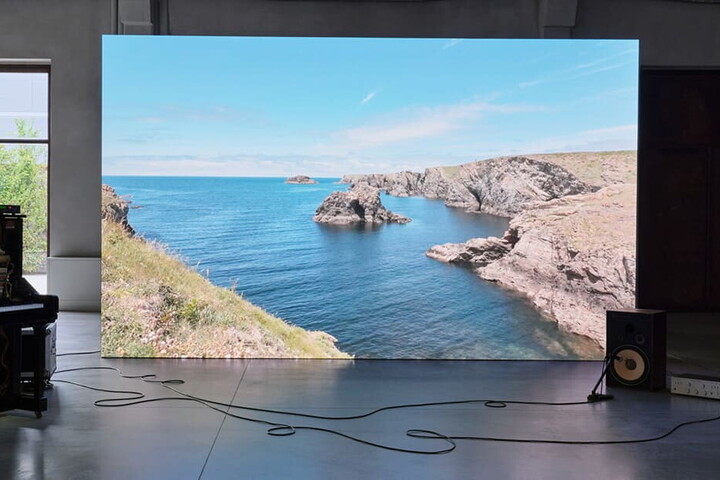On Thursday 26 January, Situations, the Kishio Suga exhibition at Pirelli Hangar Bicocca (which opened in September last year and is scheduled to end on 5 February) expanded thanks to Vibrating Fields, a performance proposed as the musical accompaniment of the exhibition, doing an excellent job to place it back under the spotlight.

The program included live performances by three leading experimenters in electronic music over the last twenty years, Hanna Hartman, Thomas Ankersmit and Thomas Brinkmann. This combination with the exhibition proved to be on point, with the curator rightly confirming the common thread running through the work of the visual artist and that of the musicians.
Suga, leading artist of the Mono-ha movement born in Japan at the end of the sixties (the “school of things”), has always developed his work around a clear philosophical and aesthetic position that he has himself contributed to. In the words of the artist, “transferring things to their final state of being means shifting them to a state where they are isolated, alone” . Meaning that for Mono-Ha artists encountering an object is a matter of reciprocal alienation: in the face of technological overdevelopment (the warning of the movement, although active during the 60s and 70s, is as timely as ever), the role of the artist is no longer to manipulate things to obtain objects that meet the diverse criteria of current value, but instead to place the objects of the world in a position where they can express their own characteristics.
For Suga, this means emphasizing the experience of the major differences – between things and the world, between things and men, and between things themselves – generated by this encounter, leaving space for potential convergence and mutual understanding.

Likewise, musicians such as Hartman, Ankersmit and Brinkmann, although expressing themselves in rather different ways, do not stray from the experimental school that first thought of sound as an object. According to founder Pierre Schaeffer, musique concrète focuses on exploring the physical aspects of sound. Schaeffer's work opened the door to a world of unusual music, a world of equivalence where each element is involved in the composition of a soundscape.
This is the connection, which for Pedro Rocha takes the form of a “lucky coincidence between the observation of phenomena and material sensitivity”, linking the performance of the musicians invited to the installation by the Mono-ha artist.
If, as Frank Zappa once said, writing about music “is like dancing about architecture”, what rhetorical devices come to mind when we have to write about music? In the case of electronic music over the last twenty years, ironically the answer is architecture, as well as design, geology and the kingdom of things we consider “inanimate”. So it is common for a drone to be described as imposing, a monolithic noise composition, with a granite tonal profile.

Hanna Hartman reverses the question: what does a soft object sound like? What sound quality does one surface rubbed against another with different properties have? Her live performance, which opened Vibrating Fields, was a composition for marble balls, flour, vials filled with water and metal rods. Constantly contradicting our expectations, her tools were transformed into magical objects before our eyes, forming the arsenal of a sorcerer's apprentice or an especially eccentric Renaissance humanist. Able to express their intrinsic properties, these common objects become estranged, before going back to normal.
Thomas Ankersmit makes the physical aspects of sound concrete in the listening experience: the master of the “Serge” synthesizer (which earned him collaborations with world famous experimental musicians including Jim O'Rourke and Italian Valerio Tricoli) presented Otolith, an electroacoustic composition, which, as the title suggests, becomes concrete in our ears. The subjective position of the body is central to the listening experience: by tilting your head down towards your chest, you can hear the higher frequencies disappear. Paradoxically, the “activating” potential of sound makes us feel less human: it is as if the sound itself was an entity in search of an activation device in the audience, witnesses of its appearance. Even the curator speaks of a “shared coexistence at a certain time in a certain area: vibrating fields”. What humanises Ankersmit – and reconciles us with our own humanity – is his awareness that each spectator experiences a performance as different, unique and irreplaceable as his or her own body.
The conceptual circle was closed by Thomas Brinkmann, for many the highlight of the evening. The experimental electronica veteran with a solid techno background performed pieces from his recent What You Hear (Is What You Hear) and, more importantly, from 2000 classic Klick, an obscure and elusive disc: techno dub with a concrete base, crucial in the creation of the glitch aesthetic that proliferated from the mid-90s.
What Brinkmann does is as simple as much as it is astonishing. By scratching and marking the surface of vinyl discs, he creates mechanical rhythms that he mixes live, inspired by a dub approach to the diffusion of sound. Here the error in glitch music is extremely procedural and precise, concrete and controlled. Brinkmann concluded the evening with what came close to a DJ set, a small selection of his old pieces, visibly grateful for such a warm and exquisitely human reception.




